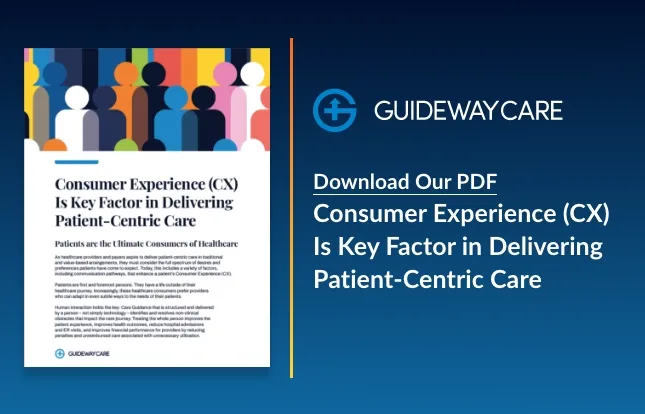Value-Based Contracts Reward Health Equity Improvements

Key Points
- Providers participate in value-based reimbursement models that incentivize health equity
- Care guidance is the perfect extension to unlock value from quality payment programs
Now more than ever, care guidance is becoming a “must have” addition to the service portfolio of health systems, hospitals and provider organizations that are taking on shared risk with payers through value-based contracts. These providers are electing to participate in new arrangements that link payments to measured outcomes, health equity improvement, and overall quality performance indicators, such as hospital admissions, readmissions and closing gaps in care.
“The transition from traditional fee-for-service to value-based healthcare is rapidly accelerating as policymakers, regulators and payers align the efficacy of health equity initiatives with quality payment strategies,” says Tina Graham, chief operating officer, Guideway Care. “Care guidance is at the nexus of this change as an innovative approach to patient activation that is delivering ‘high-value, high-quality care’ to health plan members and Medicare beneficiaries and meeting incentivized provider goals in managed, value-based arrangements.”
Payers increasingly seek opportunities to share risk with providers that can demonstrate their performance. For example:
Blue Cross Blue Shield of Massachusetts recently announced four value-based agreements that link financial incentives to improvements in health equity with the state’s largest health systems. The plan says the move is the first in the state and among the first in the nation to create a financial payment model rewarding providers for eliminating inequities in patient care. According to Andrew Dreyfus, the insurer’s CEO, “We’re now building on that model to help health systems in our value-based payment programs improve equity.”
For providers who have not otherwise adopted value-based payment arrangements, the Centers for Medicare & Medicaid Services (CMS) imposes penalties through programs such as that Merit-Based Incentive Payment System (MIPS) and the Hospital Readmission Reduction Program (HRRP). The program supports the national goal of improving health care for Americans by linking payment to the quality of hospital care. Hospitals risk mandatory reimbursement reductions, capped at 3%, for reporting an excessive number of avoidable readmissions for each patient condition or procedure within a 30-day period post discharge.
Many of these new payment arrangements prioritize health equity goals and emphasize the need to overcome disparities in care and social determinants of health (SDoH) for underserved patient populations. Avoidable readmissions are statistically attributed to SDoH issues that pose barriers to patient adherence, compliance and increases a hospital’s risk score. This is why addressing health equity among hospital systems is clinically and economically important.
Shared Savings Opportunities for Advancing Heath Equity
CMS introduced quality payment programs (QPP) as a value component to the accountable care organization (ACO) model which specifically offers shared savings to provider groups for advancing heath equity.
- The newly designed ACO Realizing Equity, Access and Community Health (REACH) model introduces an innovative payment approach requiring all participants to develop and implement a robust health equity plan to identify underserved communities and take initiative to measurably reduce health disparities within their patient populations.
- The Merit-Based Incentive Payment System (MIPS) and the Advanced Alternative Payment Models (APMs) give added incentive payments to providers who achieve high composite performance scores for quality, cost-efficient care that attains the highest level of health for all. The difference between MIPS and APMs is the amount of risk physicians are willing to take on and the amount of the payment adjustment they receive for trying to transition to a value-based care model.
As more provider organizations prioritize equity-focused healthcare delivery, they need solutions to help them successfully meet QPP goals and achieve optimal financial and operational performance. The adoption of a care guidance solution is the ideal extension of QPP models to unlock value from these incentive-based contracts. When care guidance is implemented as a multi-point model, it helps improve CAHPS scores and Medicare Star Ratings.
Guiding the Future of Equitable Healthcare
Guideway Care collaborates with health systems, hospitals and providers through an integrated care guidance program driven by a shared objective of improving health equity. Highly trained “Care Guides”’ activate patients through a combination of human engagement, technical innovation and workflow protocols that proactively uncovers and resolves disparities that pose barriers to care access and delivery – risk factors that potentially lead to avoidable health deterioration and utilization. Clinical staff receive the extended support they need to ensure the delivery of equitable, cost-effective quality care that optimizes patient satisfaction and generates the best possible outcomes. This is where the proposition of care guidance presents the most value to all shareholders.
Contact us for insight into how Guideway Care, as your partner, can implement an efficient and effective care guide solution to support your clinical team and deliver on the promise of health equity based on the needs of the patient populations in your community.
Contact Us Today To Learn How We Can Help
"*" indicates required fields




